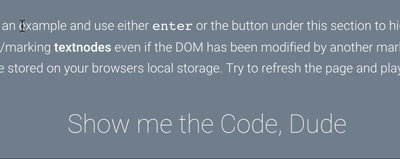marklib v0.11.0
marklib
A simple and fast zero-dependencies-library to transform text-selections into serializable markings.

Install
marklib can be installed with npm or bower.
npm install --save-dev marklib
bower install marklib --save
Usage
Render by selection
// obtain a selection from document
var selection = document.getSelection();
// create a new rendering based on the current document
var renderer = new Marklib.Rendering(document, options, context)
renderer.setId('myRenderId') // if an ID is not provided, a autogenerated one will be used
// renders the given selection and returns a result (`RenderResult`).
var result = renderer.renderWithRange(selection.getRangeAt(0));Important: After a Rendering has been used to render a selection/serialized result,
it can't be used to render something again. You need to create a new Instance of Rendering.
Options
You can pass options to each rendering instance, the following shows the default options
var renderer = new Marklib.Rendering(document, {
hoverClass: 'marklib--hover',
treeClass: 'marklib--tree',
// Supports arrays and/or strings
className: ['marking']
});Events
Marklib triggers events that can be listened to with instance.on('event-name'). Events are build with
wolfy87-eventemitter (https://github.com/Olical/EventEmitter). The following Events are available:
Before you can actually receive events, you need to register the event handler with registerEvents (use import { registerEvents } from 'marklib/src/main/RenderingEvents'; on your application bootstrap code.)
| Event-Name | Description | Arguments |
|---|---|---|
click | triggered when clicked on a marking. | (originalEvent, instanceHierarchy) |
hover-enter | triggered when a pointer-device starts hovering over a marking | (originalEvent, instanceHierarchy) |
hover-leave | triggered when a pointer-device leaves a marking | (originalEvent, instanceHierarchy) |
Additionally, marklib will add hover classes to the current hovered marking.
Constructor Arguments
- 1)
HTMLDocumentdocument -> the document instance used - 2)
Objectoptions, optional -> an object containing setting for marklib (see Options) - 3)
HTMLElementcontext, optional -> the context used to serialize / deserialize the rendering, if not given the document instance.
Render by serialized result
A Serialized results consist of 2 strings (start end end) in the following form
'body>section;0;1'`
-▲------------▲-▲ - ▲ The first part defines a css-selector (queryable with document.querySelector).
- ▲ The second part defines the text-node inside the given selector
- ▲ The third part defines the string-offset inside this text-node
Example
// This is the result we get from `RenderResult#serialize()`
var result = {
startContainerPath: 'body>section;0',
endContainerPath: 'body>section;1',
startOffset: 2,
endOffset: 5
}
var rendering = new Marklib.Rendering(document);
rendering.renderWithResult(result);Use-Cases
- Annotations
- Collaboration tools
- Inline-Commenting (I actually started a project that will do something like this: https://github.com/BowlingX/commentp)
Develop
npm run develop or npm run tdd (to start karma in watch mode)
License
The MIT License (MIT)
Copyright (c) 2015 David Heidrich
Any contribution is welcome, just issue a pull-request or bug/feature if you found something :)
9 years ago
9 years ago
10 years ago
10 years ago
10 years ago
10 years ago
10 years ago
10 years ago
10 years ago
10 years ago
10 years ago
10 years ago
10 years ago
10 years ago
10 years ago
10 years ago
10 years ago
10 years ago
10 years ago
10 years ago
11 years ago
11 years ago
11 years ago
11 years ago
11 years ago
11 years ago
